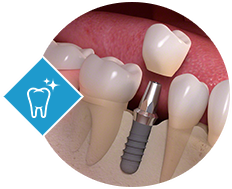
A beautiful smile - the best make-up you can wear ”
- Introduction
- Dental Implants.....The Natural Solution
- Benefits of Implants
- What Are The Types of Dental Implants?
- Bone Grafting
- The Implant Placement Procedure
- The Dental Implant Case Types
- Immediate Function Implants
- Mini Implants
- Immediate Post Extraction Implants
- Are You A Candidate For Dental Implants?
- Frequently Asked Questions
- Before & After Photographs
Introduction
There is a certain feeling each of us has when we look into the mirror and feel really confident about our appearance. It "sets the mood" for our day or social function. Simply stated, our personal confidence can dramatically affect our lives.

Unfortunately, missing teeth, medically known as edentulism, keeps many people from "feeling their best". Edentulism not only effects your self confidence, but also has a dramatic impact on the quality of your life.
- Edentulism may limit your choice of foods and therefore your nutrition and general health.
- Edentulism can make you feel isolated either socially or on the job.
- Edentulism can effect relationships with loved ones.
- If not treated, partial edentulism, that is missing some of your teeth, can place stress on the remaining teeth requiring them to "do more work". This can lead to further tooth loss.
- Edentulism also leads to bone loss making the "fitting’ of traditional dentures difficult or impossible.
For years the best solutions for missing teeth were bridges, removable partial or full dentures.
Partial Dentures: When several teeth are missing, a removable partial denture may provide the support needed to fill in the spaces. Partial dentures usually attach to natural teeth with unsightly clasps and hooks. These very obvious attachments can cause undue stress on the existing natural teeth and promote tooth decay.
Full Dentures:Some people can wear full dentures without fit problems, but it is not uncommon for a denture wearer to live with pain and irritation of the gums or have difficulty eating or speaking. Many denture wearers are anxious about whether or not their denture is going to slip and cause embarrassment.
Fixed Bridges:Removable teeth, no matter how well made, do not feel or function like natural teeth. Historically fixed bridges came as close as possible to the feel of natural teeth. However, this necessitates "cutting down" and crowning natural healthy teeth to support the bridge.
There’s another price to pay for edentulism. When teeth are removed, Mother Nature assumes there is no need for the bone that supported the teeth. After all, that is the primary job of your jawbone. Over time the bone slowly, yet progressively diminishes. In fact the upper and lower jaw bone gets smaller or shrinks. This process, called resorption, occurs at a more rapid rate if all teeth in the jaw are missing. But, it also occurs when just some of the teeth are missing. If left untreated, the loss of jaw bone can progress so far that a denture will no longer stay in place no matter how much sticky adhesive is used.
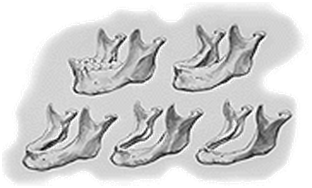 Loss of bones when teeth are lost
Loss of bones when teeth are lost
Dental Implants.....The Natural Solution
 Finally, I can enjoy eating once again
Finally, I can enjoy eating once again
Implants have given me back my confidence
For centuries man has endeavoured to find a more natural replacement for missing teeth. Modern, space age materials have allowed that quest to become a reality. Todays dental implant is possible because of these materials combined with years of research and clinical trials. The dental implant is truly the most natural solution for missing teeth.
But what exactly is a dental implant? There are basically two types of implants. Those that sit on top of the jaw bone, but under the gums and those that fit into the jawbone similar to the root of a natural tooth. Each type offers solid, non-mobile support for replacement teeth which act and feel like natural teeth. Since both types are attached to your jawbone they can provide distinct advantages over traditional methods of replacing missing teeth.
- Implants restore proper chewing function and so you can enjoy foods previously too "difficult" to eat.
- You feel confident that your replacement teeth won’t move or loosen.
- You regain the closest thing to the look, feel and function of your natural teeth.
- Throw away those gooey adhesives.
- Forget about unsightly partial denture clasps which place damaging pressure on remaining natural teeth.
- Eliminate irritated and painful gums.
- Improve your speech by eliminating or reducing the "fullness" of full or partial dentures.
- Replace missing teeth with the look and feel of natural teeth without having to "cut down" healthy teeth.
- Dental implants help stop the progressive bone loss and shrinkage of your jawbone by "mimicking" the roots of natural teeth.
- Dental implants are clinically proven with a success rate in excess of 90%.
Benefits of Implants

In almost every instance dental implants are a high quality solution for the missing teeth. In favor of implants, there are many advantages to consider, including:
Cosmetic :Dental implants are ideal replacements for missing teeth in your smile. They feel, look and function just like your own teeth. They help preserve bone and facial support and maintain the natural brilliance of a wonderful smile.
Confidence : Dental implants help restore your confidence to eat and speak again with comfort and without embarrassment. If you have a loose ill-fitting denture, implants provide much needed security from the annoying slippage, and freedom from the ever worrisome sore spots. You’ll enjoy not having to worry about lost or broken dentures, or the never-ending hassle of smelly denture adhesives.
Tooth Saving : Dental implants don’t require neighboring teeth for their support and function. The benefit her is that you don’t have to depend on or use adjacent teeth, a noteworthy benefit to your long-term oral health!
Function : Whether you are missing one, many or all of your teeth, imagine being able to chew just about anything – just like having your own natural teeth! Implants also help support and maintain normal jaw and jaw joint functions
Reliable : Modern implant solutions not only make for some great smiles and provide for superb function, they are quite comfortable and are very durable. Imagine not having to worry any more about broken teeth or root canals on teeth that are questionable. Because implants are so predictable and durable they are an all around great choice for tooth replacement.
What Are The Types of Dental Implants?
There are many implants available, each designed for a specific function. Most are made of titanium, an inert metal which has been proven to be effective at fusing with living bone, a process known as "Osseo integration". The cylindrical or screw type implant, called "root form", is similar in shape to the root of a tooth with a surface area designed to promote good attachment to the bone. It is the most widely used design and generally placed where there is plentiful width and depth of jawbone. Where the jawbone is too narrow or short for immediate placement of root form implants the area may be enhanced with bone grafting to allow for their placement.
When the jawbone is too narrow and not a good candidate for bone grafting, a special narrow implant, called " plate form ", can be placed into the bone. In cases of advanced bone loss, the "subperiosteal" implant, may be prescribed. It rests on top of the bone but under the gums.
Root Form Implants
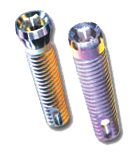
The root form implant is the most commonly used implant. It is a screw-type implant shaped like the root of a tooth. This type of implant is used when there is ample width and depth to your jawbone. If your jawbone is too narrow or short for placement of a root form implant, then bone grafting may be needed to allow for placement. After you have received anesthesia, your dentist will expose an area of your jawbone and prepare the bone for the implant. The number of incisions and bone preparations depends on how many implants you need. The implant will be set into place, and then your gums are closed with stitches. It takes three to six months to heal. After you've fully healed, your implant is uncovered and an abutment is attached.
Plate Form and Blade Implants
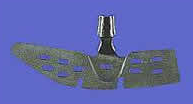 Blade implant specifically designed for the back-most portion of the lower jaw.
Blade implant specifically designed for the back-most portion of the lower jaw.
A plate form implant is used when a patient's jawbone is too narrow for bone grafting. This type of dental implant can be placed directly into the jawbone. The plate form implant has a flat, long shape that makes it unique and allows it to fit better into a narrow jawbone.
After you've received anesthesia, your cosmetic dentist will expose an area of your jawbone and prepare the bone for the implant. The number of incisions and bone preparations depends on how many implants you need. The implant will be set into place and your gums are closed with stitches. Generally, it takes three to six months to heal, but some plate form implants are immediately ready for restoration without the long healing process.
Subperiosteal Implants
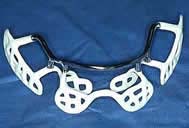 Subperiosteal implant for the lower jaw. This particular implant has a whitish-gray hydroxyapatite coating on its bone-contacting portion
Subperiosteal implant for the lower jaw. This particular implant has a whitish-gray hydroxyapatite coating on its bone-contacting portion
The subperiosteal implant is a custom-made implant that rests on the top of a patient's jawbone and under the gums. This type of implant is recommended when there is not enough bone width or height for the root form or plate form implants. The subperiosteal implant is placed through one of two special methods.
The first method of placement involves your dentist making an impression of your jawbone. After you've received anesthesia, the dentist exposes your jawbone and takes an impression of it. A dental lab then uses the impression to make a custom-fit implant for your jaw. After your custom-fit implant is created, your dentist exposes the jawbone again to set the implant in place. Your gums are then closed with stitches and replacement teeth are installed.
The second method of placement requires a CAT (computerized axial tomography) scan of your jawbone. Through computer modeling techniques, a model of your jawbone is made from the CAT scan information. After a dental lab creates your custom-fit subperiosteal implant, your dentist exposes your jawbone and places the implant. The gums are then closed with stitches and replacement teeth are installed.
Bone Grafting
Sometimes, when resorption has excessively reduced the jawbone, it can be rebuilt through modern bone grafting techniques. Bone grafts can build up or fill in jawbone defects allowing the placement of dental implants. These techniques represent one of the greatest advances in modern dentistry.
There are generally four types of bone grafts used:
- Autografts are those where the bone to be grafted to the jaw is taken, or harvested, from your own body. The area where the bone is harvested from, known as the donor site, is usually the mouth or the hip. This is your own bone and is very compatible with your body. Autografts are generally the best graft technique and usually result in the greatest regeneration of missing jawbone.
- Allografts are taken from human donors. Many countries have donor programs where you can specify that in the event of your death, parts may be harvested from your body to save or improve the life of others. Heart transplants are one type of allograft. This can represent one of the greatest "gifts" you can ever give. Bone obtained in this mannor undergoes rigorous tests and sterilization. Your body "converts" the donor bone into your natural bone, thereby rebuilding your resorbed jawbone.
- Xenografts are harvested from animals. The animal bone, most commonly bovine (cow), is specially processed to make it biocompatible and sterile. It acts like a "filler" which in time your body will replace with natural bone. After this replacement process is complete dental implants may be placed to support teeth.
- Alloplastic grafts are inert, man made synthetic materials. The modern artificial joint replacement procedure uses metal alloplastic grafts. For bone replacement a man made material that mimics natural bone is used. Most often this a form of calcium phosphate. Depending on how it is made, it may be "resorbable" or "non-resorbable". That is, your body may or may not replace the alloplastic graft with your natural bone. In those cases where it is not replaced it acts as a lattice or scaffold upon which natural bone is built. In either case, the end result is to create enough bone for the placement of dental implants.
Modern bone grafting techniques can be nothing short of a miracle for those needing bone replacements. Should your doctor recommend this treatment you will be given further information on the type, location and amount of graft needed.
The Implant Placement Procedure
The Two-Stage Procedure
The Two-Stage Procedure First Stage : Surgical placement (can be done with a local anaesthetic) Second Stage : Uncovering of the implant
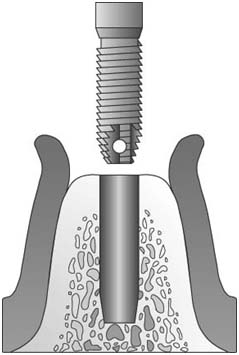 Step 1 The implant is screwed or tapped into a surgically prepared site. The gum tissue is closed over the implant.
Step 1 The implant is screwed or tapped into a surgically prepared site. The gum tissue is closed over the implant.
 Step 2 The implant remains under the gum for 3 to 6 months. The patient continues to wear their denture during this period.
Step 2 The implant remains under the gum for 3 to 6 months. The patient continues to wear their denture during this period.
 Step 3 (3 to 6 months later) The implant is exposed by removing a small amount of gum tissue. An insert can be screwed down into the implant
Step 3 (3 to 6 months later) The implant is exposed by removing a small amount of gum tissue. An insert can be screwed down into the implant
 Step 4 The secured insert can accommodate various attachments upon which overdentures, bars, crowns, or bridges.
Step 4 The secured insert can accommodate various attachments upon which overdentures, bars, crowns, or bridges.
The Dental Implant Case Types
These different case types are defined by whether all or only some teeth are missing, and also by the type of replacement teeth to be built upon the implants
1.Where all of the teeth in an upper or lower arch are missing - called completely edentulous.
- The Ball-and-Socket Removable Overdenture.
- The Bar-Retained Removable Overdenture.
- The Screwed-in Fixed Bridge.
- The Cemented Fixed Bridge.
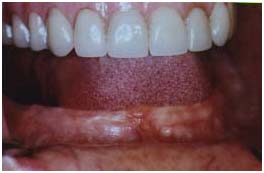
2. Where only some of the natural teeth are missing - partially edentulous.
- The Fixed Bridge - cemented or screwed-in.
- The Single Tooth Replacement.
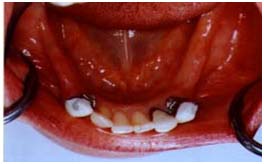
1. Where all of the teeth in an upper or lower jaw are missing - completely edentulous
The Ball-and-Socket Removable Overdenture
- May require 2-4 implants depending on the amount and quality of bone present.
- This may be the simplest way to replace an ill-fitting denture.
- This type of overdenture is better suited for the lower jaw instead of the upper jaw.
- The implants have "ball-type" inserts screwed or cemented into them.
- These inserts will then fit into "O-ring" type of recipient sites in the underside of the denture.
Case a :
 |
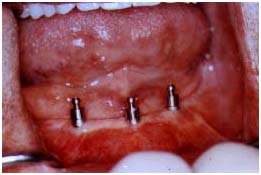 |
| Pre Treatment | Post Treatment |
The Bar-Retained Removable Overdenture
- May require 2-6 implants depending on the amount and quality of bone, as well as for which jaw (upper or lower) the overdenture is being planned.
- The bar-retained overdenture is frequently used in the upper jaw if the patient has had a severe gagging problem with a conventional full upper denture.
- When patients have had severe bone resorption from previously wearing a lower denture, a new denture or a ball-and socket supported implant overdenture which rests on the gums may "pinch" the nerve which rests on top of this severely resorbed ridge. The bar-retained overdenture is recommended since the overdenture rests on the bar, not the gum tissue.
Case b :
This 48 year old woman has had very sensitive gums under her denture. Her mouth is also "dry" since the medication that she takes reduces the amount of saliva in her mouth.
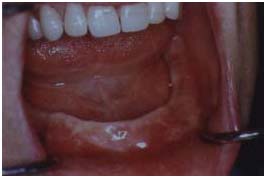 Pre Treatment
Pre Treatment
This view of her lower jaw shows that her ridge is thin and "knife-edged". This, in combination with her dry mouth, has contributed to her inability to be satisfied with a normal lower denture.
 The X-Ray Analysis
The X-Ray Analysis
This x-ray shows that 4 implants have been placed as "pairs" on each side of the front of the lower jaw. This "pairing" of the implants leaves room for more retention on the bar in the front of the mouth, as well as back on the sides of the bar. However, there are also reasons in some cases to evenly space the implants instead of "pairing" them.
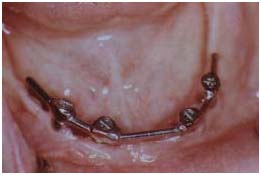 The Completed Case
The Completed Case
This view of her mouth shows how the bar is secured into the 4 implants by small screws. The bar will then serve to retain the overdentue since the overdenture has small "clips" on its underside. These clips will grasp the bar and provide a very satisfactory retention. A ball-and-socket retention can also be created on this type of a bar.
 The Underside of the Overdenture
The Underside of the Overdenture
Small metal or plastic clips are imbedded into the denture. These clips will attach to the bar. Another option is the use of ball-and-socket type attachments.
The Screwed-in Fixed Bridge - sometimes called the Fixed Detachable Bridge May need 4-8 implants depending on the amount and quality of the bone present. However, in most cases, 4 implants won't be adequate.
An option for those patients who don't want anything removable in their mouth. The teeth are built upon a metal base through which screws are inserted and, in turn, secure the teeth into the implants.
The metal base does not come into contact with the gums and sits, like a "platform" above the gums. This "high water line" may be inconvenient for some cases, especially for upper teeth replacements. If this is a concern, the use of crowns, which go over the implants, may be a better, although more costly, option.
Case c :
This 62 year old male has worn upper and lower full dentures for 31 years. His lower denture is unsatisfactory and he doesn't want any removable implant replacement.
 Pre Treatment
Pre Treatment
The upper teeth are pleasing to him and will not need implant replacements. His lower ridge still has enough bone to allow for six implants to be placed between the nerves.
 The X - Ray Analysis
The X - Ray Analysis
The x-ray shows the six implants as the vertical white screws. The metal base upon which the teeth are built is white and on the horizontal plane.
 The Completed Case
The Completed Case
This view shows the teeth and the pink plastic which looks like the gum tissue. Under the "gums" are the gold "collars" which are connections to the implants which are under the gum tissue. You can notice the space between the underside of the teeth and the patient's gum tissue.
d. The Cemented Fixed Bridge
4-10 implants may be needed. Four implants would not be adequate in most situations. Ten implants, or in some cases even more, may be used when the amount of bone only allows for very short implants.
This type of reconstruction feels more natural to the patient since crowns are placed over the implants. These crowns then support replacement teeth which look and feel just like crowns.
The patient's ability to clean around the crowns and implants is ideal when considering implant reconstructions in jaws which have no teeth.
Case d :
This 43 year old woman has never been happy with a full lower denture. She is very concerned with her appearance and wants her mouth to look as good as the rest of her.
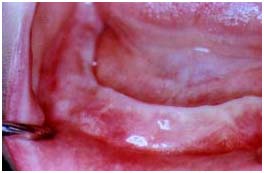 Pre Treatment
Pre Treatment
This view of her lower jaw shows a ridge which won't provide much retention for a lower denture. Most lower jaws with no teeth will not create any suction for a lower denture. She has significant bone loss in the back area of the jaw and implants can only be placed in the front of the jaw, between the nerves.
 The X - Ray Analysis
The X - Ray Analysis
The x-ray shows that there are 6 implants which appear as the vertical screws. The crowns are built upon the implants and two crowns are extended horizontally from each side of the last implant. These extended crowns are supported.by being connected to the crowns which are cemented onto the implants. These extended crowns are called "cantilevered crowns".
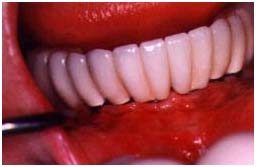 The Completed Case
The Completed Case
This view shows the actual crowns which have been built upon the implants. The appearance and form of the crowns not only look natural, but also allow for easy cleaning around the crowns and the implants. This type of case provides excellent satisfaction for the patient.
2. Where only some of the natural teeth are missing, implants can replace a removable partial denture.
- The Fixed Bridge - cemented or screwed-in
- The Single Tooth Replacement
The determination as to what type of tooth replacement is to be used is made based on the number of teeth missing and from where in the jaw they are missing. Some missing teeth may be replaced without implants if there are strong teeth on both sides of the gap from which teeth are missing. However, if the gap is too long from too many teeth being missing, implants will be needed in order to provide additional support for the replacement teeth. If the missing teeth are at the back of the jaw and there are no teeth at the very back of the jaw upon which a bridge could be built, then implants are the only way that a fixed, non-removable replacement can be constructed.
The Fixed Bridge - cemented or screwed-in
- May be built upon implants only or in combination with implants and natural teeth providing the support required for the replacement teeth.
- Crowns are built upon the implants, and also on natural teeth if that is the desired treatment plan. These crowns can be attached to the implants by being cemented or screwed into the implants. -- any crowns placed upon natural teeth would be cemented on.
- Oral hygiene procedures around the crowns and implants can be achieved readily. The number of implants used varies depending upon the number of teeth to be replaced.
Case a :
This 47 year old woman has lost most of the back teeth in her lower jaw. She wears a full upper denture with which she is not unhappy. However, she is unhappy with her lower partial denture which she had worn for 22 years.
 Pre Treatment
Pre Treatment
This view is of the lower jaw just as if we are looking directly down on the six remaining teeth. These are her front six teeth at the bottom of the picture. The missing back teeth would have been vertically above the front teeth as we view this picture. This will be clearer when you see the completed case and see where the replacement teeth go.
 The X - Ray Analysis
The X - Ray Analysis
This x-ray was taken after the crowns were built upon the implants. There were six implants used and these are seen as the six vertically projecting white screws going down from the white crowns.
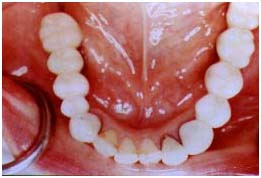 The Completed Case
The Completed Case
This is the same view as you had on the "Pre-Treatment" view. You now can see that the missing back teeth have been replaced with crowns that were cemented onto the implants and natural teeth. These crowns could also have been secured to the implants with screws instead of being cemented.
The single tooth replacement
- May be used to replace front teeth or back teeth.
- Due to the need for pleasing bone cosmetics in the front, the bone quantity and quality at the implant site must be good or bone grafting may need to be considered.
Case b :
This case is of a 16 year old female who has what are described as "congenitally missing lateral incisors".
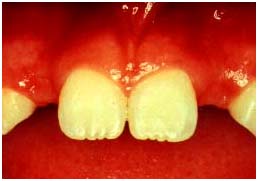 Pre Treatment
Pre Treatment
This view shows the two central incisors and the spaces lateral to these teeth which is where the lateral incisors should have been.
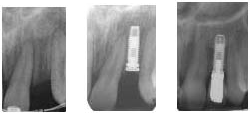 The X - Ray Analysis
The X - Ray Analysis
The x-ray on the left shows a space between the two teeth (the central incisor and the cuspid) which is where the lateral incisor would have normally been positioned. The x-ray in the middle shows the implant as a white screw which has been expertly placed between the cental incisor and the cuspid. The x-ray on the right shows the implant with the crown cemented upon it.
 The Completed Case
The Completed Case
Immediate Function Implants
One of the most attractive benefits of immediate function dental implants is the fact that you can go from having no teeth, to a fully functional set of teeth in only an hour.
There is no healing time required between the surgical and restorative procedures which mean the treatment time is shorter. For these reasons, there is less recovery time and overall greater comfort.
Historically, the placing of dental implants is comprised of two components. First, the surgical procedure takes place where the posts are implanted into the jawbone. Then after a healing time of several months, the prosthetic placement of the denture or dental appliance is attached.
With immediate function dental implants, the posts are precisely placed by computer technology. This sophisticated technology enables the posts to be positioned within the designated sites in such a way that limits the movement of the implant. The dental prosthetic product can then be placed in the same appointment.
Mini Implants
With the latest technology in dental implantology, Mini Dental Implants may be the answer to your denture problems. Visit your dentist in the morning, have Mini Dental Implants placed in about an hour, then leave the dental office with stable secure dentures attached to your Mini Dental Implants. Imagine eating, speaking and smiling with confidence. Your denture feels secure and is being held firmly in place thanks to Mini Dental Implants. A small miracle in implant dentistry. And all this in about an hour with no cutting of the gums and no stitches to have removed. This unique procedure can be completed in one visit with virtually no discomfort.
Immediate Post Extraction Implants
Immediate post extraction implant placement is very simply, the placement of an implant into a fresh extraction socket. It may or may not be accompanied by augmentative procedures. The approach to the restoration of this implant then throws up three possibilities, one option is to load this implant conventionally after osseo-integration has taken place (delayed loading), the second option is to load it with in two weeks with a restoration that is not under the impact of direct occlusal load (progressive loading). Alternatively you may choose to load this implant within 48 hours, a procedure referred to as immediate loading.
Of course, you may choose not to place an implant immediately after extraction at all and you may opt to place it after complete bone healing. At that point, you would again choose between the same options of immediate loading.
The choice of immediate post Extraction Implant placement.
Immediate implant placement after extraction has become a favoured treatment protocol with many clinicians worldwide. There are many advantages to this protocol, amongst them; shortened treatment time, placement of the implant in sound bundle bone that constitutes the socket wall, placement trajectory guidance by the socket and preservation of bone volume. A decision to place an implant in a fresh extraction socket must only be made if there is an absolute assurance of primary stability. An evaluation of the extracted root will often yield valuable information as to the length and diameter of the implant to be placed. Also important is an assessment of the trajectory of the socket-a malpositioned tooth would have a malposition trajectory often rendering the implant difficult to restore. The presence of infection might predispose the placed implant to failure and it is hence important to evaluate why the tooth is been extracted in the first place. There is also evidence to suggest that use of the right implant design is critical to success, tapered implants with rough surfaces may be more suitable.
Are You A Candidate For Dental Implants?
Whether you are a young, middle-aged or older adult; whether you need to replace one tooth, several teeth, or all your teeth, there is a dental implant solution for you. With the exception of growing children, dental implants are the solution of choice for people of all ages, even those with the following health concerns:
Existing Medical Conditions. If you can have routine dental treatment, you can generally have an implant placed. While precautions are advisable for certain conditions, patients with such chronic diseases as high blood pressure and diabetes are usually successful candidates for dental implant treatment.
Gum Disease or Problem Teeth. Almost all implants placed in patients who have lost their teeth to periodontal disease or decay have been successful.
Currently Wearing Partials or Dentures. Implants can replace removable bridges or dentures, or they can be used to stabilize and secure the denture, making it much more comfortable.
Smokers. Although smoking lowers the success rate of implants, it doesn't eliminate the possibility of getting them.
Bone Loss. Bone loss is not uncommon for people who have lost teeth or had periodontal disease. Oral and maxillofacial surgeons are trained and experienced in grafting bone to safely and permanently secure the implant.
Implant tooth replacement in children is usually deferred until their jaw growth is complete. There are, however, some instances when a dental implant may be appropriate, such as when it is part of the child's orthodontic treatment plan. Your family dentist or orthodontist can guide you in this instance.


"We care for your smile better"
Contact us now to schedule an appointment.

